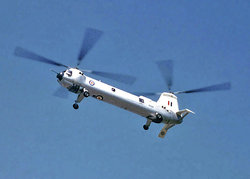Bristol Aeroplane Company
|
|
The Bristol Aeroplane Company (formerly British and Colonial Aeroplane Company) began building primitive Bristol Boxkites in a former tram shed and became famous for the production of the war-time Blenheim and Beaufighter, the Brabazon airliner prototype, the Britannia and Freighter and the Belvedere and Sycamore helicopters. A stainless steel test aeroplane, the Type 188, was also constructed in their factory next to Filton aerodrome to the north of Bristol city centre. In 1959 Bristol was forced to merge with English Electric, Hunting Aircraft and Vickers-Armstrongs to form the British Aircraft Corporation (BAC), later to become part of British Aerospace, now BAE Systems.
Missing image Britannia.red.750pix.jpg UK Ministry of Defence Bristol Britannia makes a visit to the maker's factory at Filton (Bristol, England) in 1983. As a civil airliner it had flown for BOAC, British Eagle and Air Spain. |
The Bristol Engine Company was originally a separate entity, Cosmos Engineering, in turn formed from the pre-WW1 automobile company, Brazil-Straker. In 1917 Cosmos was asked to investigate air-cooled radial engines, producing the Bristol Mercury, a 14 cylinder two-row (helical) radial, which they launched in 1918. This engine saw little use, but a smaller and simpler 9 cylinder version known as the Bristol Jupiter was clearly a winning design. In the post-war rapid downsizing of military orders the company went bankrupt, and the Air Ministry let it be known that it would be a good idea if Bristol purchased them. The Jupiter competed with the Armstrong Siddeley Jaguar through the 1920s, but Bristol put more effort into their design, and by 1929, the Jupiter was clearly superior. In the 1930s they developed a new line of radials based on the sleeve valve principle, which would develop into some of the most powerful piston engines in the world, and could continue to be sold into the 1950s. In 1956 the division was renamed Bristol Aero Engines, and then merged with Armstrong Siddeley in 1958 to form Bristol Siddeley as a part of the airframe mergers that formed BAC. In 1966 Bristol Siddeley merged with Rolls-Royce, leaving only one major aero-engine company in England, Rolls-Royce.
In 1946, with the surplus capacity after WW2, the company started an offshoot, Bristol Cars, using pre-war BMW designs as the basis for a new car, the Bristol 400. The car company became independent in 1960, around the same time as the consolidation the British aircraft industry, but is still based at the Filton site.
| Contents |
Bristol Aeroplanes
Bristol Aeroplane designs include:
WWI types:
inter-war and WWII types:
- Bristol Beaufort
- Bristol Beaufighter
- Bristol Blenheim
- Bristol Bolingbrook
- Bristol Bombay
- Bristol Brigand
- Bristol Buckingham
- Bristol Buckmaster
- Bristol Bulldog
post-war types:
helicopters:
Bristol Engines
Bristol Engine designs include:
original series:
sleeve-valve series:
turbine-based types:
Bristol Missiles
Bristol Engine designs include:
External links
- The Bristol Aeroplane Company (http://www.bristol-aeroplane.com/) (the founder's family's website)
- Bristol Aircraft and Engines (http://www.1903to2003.gov/essay/Aerospace/Bristol/Aero50.htm)
- Bristol Aircraft Engines (http://www.stobbe.dk/industrial-products/technical-literature/combustion-engines/bristol/Bristol-aircraft.htm)
|
Lists of Aircraft | Aircraft manufacturers | Aircraft engines | Aircraft engine manufacturers Airports | Airlines | Air forces | Aircraft weapons | Missiles | Timeline of aviation |

